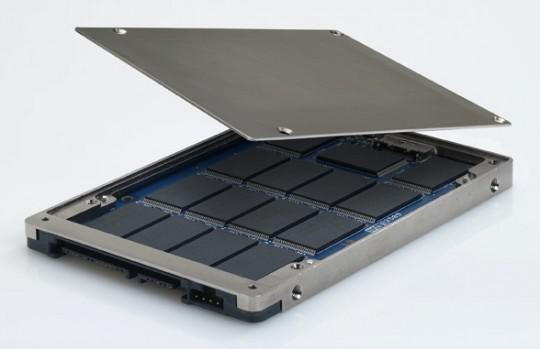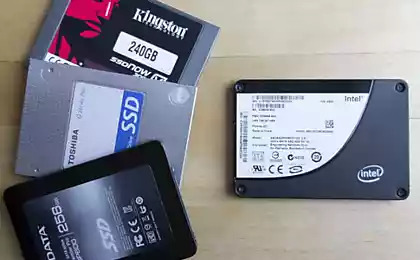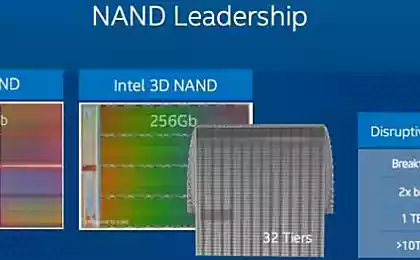1078
SanDisk announces first SSD drive 4TB volume
The undoubted advantage SSDs have been and remain a high performance and reliability, while the cost and volume are significantly lost HDD-drives. But the ice was broken. April 30, 2014, SanDisk announced the release of Optimus MAX - the industry's first SSD with a capacity 4TB. Thus, Optimus MAX SSD caught up in volume vysokoemkostnye existing HDD-drives, bringing the full time transition data centers for technology SSD.

Model Optimus MAX family headed by an updated Optimus SAS SSD. For it to be applied branded components Guardian Technology ™ based flash memory MLC NAND, made by the 19-nanometer technology.

The platform is based on the technologies FlashGuard ™, DataGuard ™ and EverGuard ™, which provide error detection and correction, data integrity and recovery of at failures. For NAND-chips it minimizes the possibility of data corruption with frequent reading on adjacent pages within the block. SanDisk says the likelihood of a fatal error reading on the new disk at 1 in 10 ^ 17. TBW (Total Bytes Written, the total amount of data that can be written to MTBF) of this model is 2176 TV.
Productivity drive reaches 70,000 IOPS on reads and 15,000 IOPS write operations to the volume at 4TB, making it a worthy replacement SAS hard disk drives for data centers.
Most companies rely on the 10K and 15K rpm SAS drives for mission-critical applications because they provide high performance at relatively low cost. However, as the increase in the volume of data and access to real-time information is becoming increasingly important, the market comes to the fact that traditional hard drives can not meet its requirements. Optimus MAX SSD offers an effective alternative, with a high storage density and performance of SSD-class that allows businesses to replace insufficiently effective hard drives, using their existing storage infrastructure based on SAS. With Optimus MAX SSD customers can significantly reduce the cost of maintaining the infrastructure by reducing power consumption, heat dissipation, as well as the smaller size of the disks themselves, which reduces the physical space used.

The market has long been waiting for opportunities to fully switch from HDD drives on the SSD. Initially, such a transition prevented the extremely high price of SSDs. With the development of technology the price is reduced, but the amount of disks still significantly inferior. SanDisk is its line of Optimus, previously includes a disk volume of 1.2, 1.6, 2 TB gradually leveled and this obstacle, catch up on the volume of the HDD. From throughout the transition to SSD only separates still relatively high price. However, if manufacturing companies will gradually abandon the development of the technology become obsolete in favor of HDD SSD, the market will soon be ready for widespread adoption in the era of SSD.
Source: habrahabr.ru/company/ua-hosting/blog/225451/

Model Optimus MAX family headed by an updated Optimus SAS SSD. For it to be applied branded components Guardian Technology ™ based flash memory MLC NAND, made by the 19-nanometer technology.

The platform is based on the technologies FlashGuard ™, DataGuard ™ and EverGuard ™, which provide error detection and correction, data integrity and recovery of at failures. For NAND-chips it minimizes the possibility of data corruption with frequent reading on adjacent pages within the block. SanDisk says the likelihood of a fatal error reading on the new disk at 1 in 10 ^ 17. TBW (Total Bytes Written, the total amount of data that can be written to MTBF) of this model is 2176 TV.
Productivity drive reaches 70,000 IOPS on reads and 15,000 IOPS write operations to the volume at 4TB, making it a worthy replacement SAS hard disk drives for data centers.
Most companies rely on the 10K and 15K rpm SAS drives for mission-critical applications because they provide high performance at relatively low cost. However, as the increase in the volume of data and access to real-time information is becoming increasingly important, the market comes to the fact that traditional hard drives can not meet its requirements. Optimus MAX SSD offers an effective alternative, with a high storage density and performance of SSD-class that allows businesses to replace insufficiently effective hard drives, using their existing storage infrastructure based on SAS. With Optimus MAX SSD customers can significantly reduce the cost of maintaining the infrastructure by reducing power consumption, heat dissipation, as well as the smaller size of the disks themselves, which reduces the physical space used.

The market has long been waiting for opportunities to fully switch from HDD drives on the SSD. Initially, such a transition prevented the extremely high price of SSDs. With the development of technology the price is reduced, but the amount of disks still significantly inferior. SanDisk is its line of Optimus, previously includes a disk volume of 1.2, 1.6, 2 TB gradually leveled and this obstacle, catch up on the volume of the HDD. From throughout the transition to SSD only separates still relatively high price. However, if manufacturing companies will gradually abandon the development of the technology become obsolete in favor of HDD SSD, the market will soon be ready for widespread adoption in the era of SSD.
Source: habrahabr.ru/company/ua-hosting/blog/225451/























